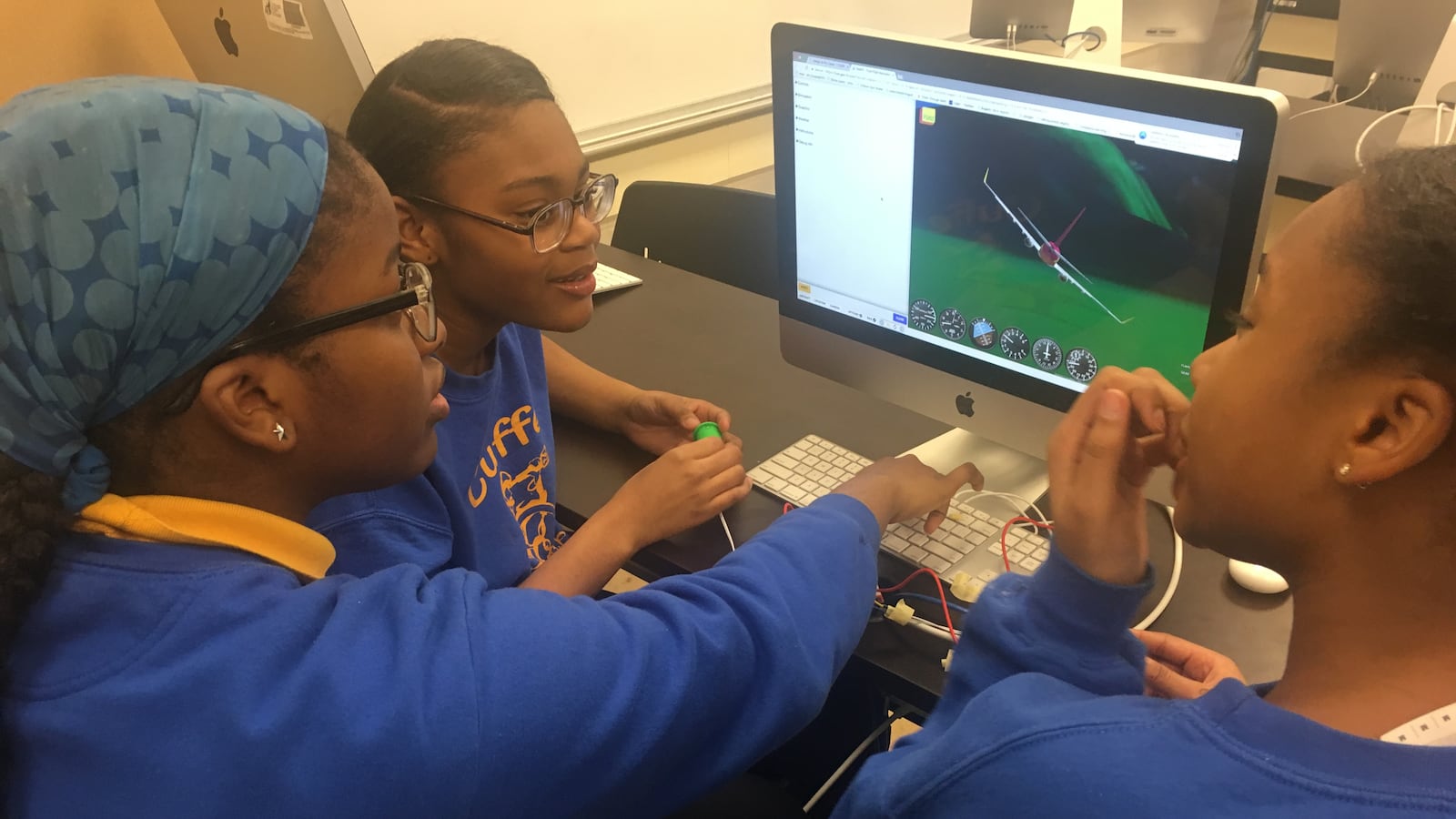Principal Lakita Reed labored for a month with more than a dozen other educators at Paul Cuffe Math-Science Technology Academy to compile a 50-page proposal that re-envisioned their Auburn Gresham campus as a STEM school. Reed said she cried tears of joy when the district called Monday after school with word that their plan was approved.
“We were ecstatic,” Reed said about the funding to become an official science, technology, engineering and math campus. “We were running up and down the halls.”
On Tuesday, Mayor Rahm Emanuel and the school district’s Chief Academic Officer Latonya McDade visited Cuffe to announce that Chicago will spend $32 million on expanding high-demand academic, art, and dual-language programs to 32 more campuses that survived the same highly competitive application process as Reed.
Out of 102 principals who signaled interest, one-third landed a new program.
“We’ve never made this much investment in International Baccalaureate, science and technology, and artistic education in our neighborhood schools across the city of Chicago,” Emanuel said Tuesday in the library of the elementary school, which is Level-1 rated and serves about 300 students, nearly all of them black.
Related: In final stretch of recruitment season, Chicago high schools race to impress
The officials touted the expansion as a tool to address inequities at Chicago Public Schools, tying it to an inventory report released last year to both guide district decision-making and arm school communities with information to discuss and advocate for resources.
The Chicago Teachers Union and other critics complained that the competition was unduly burdensome, especially for under-resourced schools that might not have the time, staff or leadership to compile robust applications.
Andrea Tolzmann of parents group Raise Your Hand, which has accepted past funding from the Chicago Teachers Union, said at the last school board meeting that “many underenrolled schools did not even apply, and we’re not surprised.”
“They’re so under-resourced, how are they supposed to find the time to apply?” she said. “Why are you making the children depend on school-by-school applications for the resources they desperately need? A truly equitable approach would provide resources to those who need them the most, not require individual schools to apply for them.”
The school district has repeatedly refused Chalkbeat requests for copies of the applications from schools seeking additional programs.
Related: Chicago schools chief urges principals to apply for enrollment-boosting programs
After Tuesday’s press conference, McDade said that the program application process is meant to be equitable because it gives schools the opportunity to speak up about what they need to succeed and call for resources.
“If you look at this process, it was open to everyone, it was transparent,” McDade said.
Asked about concerns that not all schools might be positioned to compete, she said that officials would be studying the process to glean ways to support schools when the annual process starts again next school year.
McDade said that the winning proposals showed support from their communities, sustainable plans for implementing new programs, and needs that align with data in the school inventory report, known as the Annual Regional Analysis. The district issued an updated version of that report Tuesday.
Related: The tension between Chicago enrollment declines and new schools
The latest report, like the one released last year, projects further declines in enrollment and illustrates details on troubling trends: Top-rated schools and high-demand academic programs are disproportionately clustered in white and higher-income areas, and fewer black and Latino students have access to them. It was compiled by the district with help from Kids First, a school-choice group that focuses on empowering parents.(You can read the full report at the end of this article).
When the analysis first debuted, it spurred fears that district leaders would use it to justify closing neighborhood schools or opening charter schools in areas where neighborhood schools were deemed underachieving or inadequate options. So far, the district has used the report as rationale to deny one charter school’s proposal to open a second campus (a decision that is now likely to be reversed by the state’s charter commission).
McDade said the city leaned on the report to inform its investments, and rejected applications that weren’t clear about how needs aligned with ARA data.
At community meetings held last year about the report, educators and parents pushed for the school district to help neglected neighborhood schools raise their profile with programmatic investments and marketing support.
Related: Here’s a closer look at Kids First Chicago, the group behind a report sparking debate
The report, Kids First CEO Daniel Anello said, now captures a more holistic view of the school district, and includes data for students in pre-kindergarten and at alternative schools, as well as data from the district’s enrollment portal, GoCPS, that shows application preferences for rising high school freshman.
“For us, a big part of our work has been how do you make the same data that the district uses for its own work accessible to communities,” Anello said. “We help people understand what the data is saying so they can come to their own conclusions about what needs to happen in their own backyards.”
Related: 5 tough questions a new report puts front-and-center for Chicago’s next mayor
Three girls working with a flight simulator program in Cuffe’s STEM lab on Tuesday didn’t know much about how or why their campus was being rebranded with more of a science and engineering focus as opposed to any others. But they were excited all the same.
“I love everything about science,” said, Vanessa Nwaige, an aspiring doctor. “If this school is going to become a science school, it’s a great opportunity for all the students.”
Editors’ note: This story has been updated to reflect that Chalkbeat asked for copies of applications of schools that applied for programming and was denied. The district posted a list of the 100-plus applicants online.
Below is a copy of the latest Annual Regional Analysis

